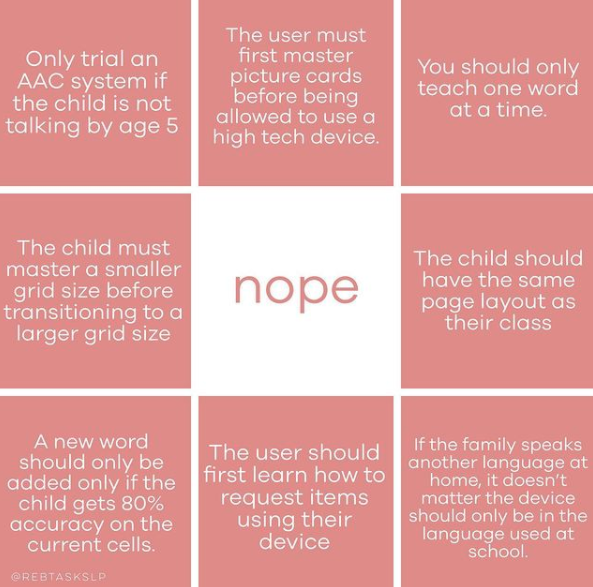
The research on the implementation, use and development of specialized AAC systems has skyrocketed in the past few years! It is important as AAC advocates we stay on top of the news and research to provide better therapy for our clients. Outdated research is outdated. When working with AAC users, we owe it to them and the families to remove biases and work on the best total approach for the AAC user. Here are some outdated misconceptions in the AAC SLP world:
Only trial an AAC system of the child is not talking by age 5… nope! This is not true at all! The earlier we get the child exposed to a robust communication system the better. Research shows (and I’ve seen with my own eyes!!) that use of AAC does not slow down verbal speech.
The user must first master picture cards before being allowed to use a high tech device… nope! This is outdated thinking. Research shows that a child should try many types of AAC systems during trial periods to figure out the best communication system.
You should only teach one word at a time… nope! You can adapt your style of teaching language to what suits the child’s needs. I like to teach following the “80/20” teaching 80% core and 20% fridge vocabulary method.
The child must first master a smaller grid size before transitioning to a larger grid size… nope! This will most likely be harder! We rely on motor planning as a means for quick and easy communication.
The child should have the same layout as their class… nope! Layouts should be customized and child specific.
A word should only be added if the child gets 80% accuracy on the current cells… nope! You will be teaching one word at a time forever. The more you are modeling the more you are “talking the talk” of AAC.
The user should first learn how to request items using their device… nope! Personally I like to work on words like “more” “want” after we work on other language functions. You don’t need to teach “more” first.
If the family speaks another language at home, it doesn’t matter, the device should be only in the language used at school…. nope! How will this ever get carried over if it’s not in a language the family communicates in?!
